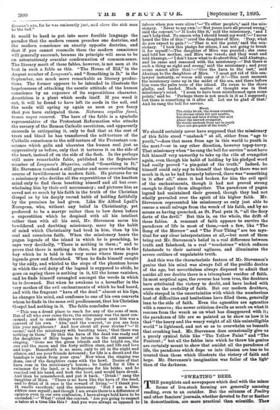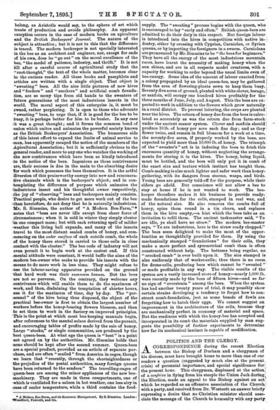"SWEATING" BEES.
T" pamphlets and newspapers which deal with the minor forms of live-stock farming are generally amusing reading, even to an outsider. But the columns of Poultry and other fanciers' journals, whether devoted to fur or feather in domestication, are more practical than scientific. They belong, as Aristotle would say, to the sphere of art which treats of production and avoids philosophy. An apparent exception occurs in the case of modern books on apiculture and the British Beekeepers' Journal. The nature of the subject is attractive ; but it is not to this that the difference is traced. The modern beekeeper is not specially interested in the bee as an architect and engineer, nor, except for ends of his own, does he "go out" on the moral excellence of the bee, "the model of patience, industry, and thrift." It is not till after a careful course of agricultural study that the "root-thought," the text of the whole matter, becomes clear to the curious reader. All these books and pamphlets and articles are written with a single object. That object is " sweating " bees. All the nice little pictures of new hives and " feeders " and " smokers " and artificial comb founda- tion, are so many tips from old hands to the sweaters of future generations of the most industrious insects in the world. The moral aspect of this enterprise is, it must be owned, rather perplexing. It is open to those who advocate " sweating " bees, to urge that, if it is good for the bee to be busy, it is perhaps better for him to be busier. In any case it was a great thought ; and it forme the common bond of -anion which unites and animates the powerful society known -as the British Beekeepers' Association. The humorous side of this latest effort to expand the limits of animal service to man, has apparently escaped the notice of the members of the Apicultural Association; but it is sufficiently obvious to the general reader, and more to any one who watches the working of the new contrivances which have been so kindly introduced to the notice of the bees. Ingenious as these contrivances are, their success is due in the main to the absorbing desire 'for work which possesses the bees themselves. It is the artful diversion of this praiseworthy energy into new and remunera- tive channels which is the beekeeper's object; and in con- templating the difference of purpose which animates the ;Industrious insect and his thoughtful owner respectively, the joy of " observing " bees and beekeepers mainly consists. Practical people, who desire to get more work out of the bee cthan heretofore, do not deny that he is naturally industrious. Mr. S. Simmins, the author of "A Modern Bee-Farm,"* notes that "bees are never idle except from sheer force of _circumstances ; when it is cold in winter they simply cluster in one compact mass; but with each returning spell of milder ,-weather this living ball expands, and many of the insects travel to the most distant sealed combs of honey, and com- mencing on the outer surface of each outside comb, the whole of the honey there stored is carried to those cells in close .contact with the cluster." The bee code of industry will not even permit it to begin work at the easiest end. If this .mental attitude were constant, it would baffle the aims of the modern bee-owner who seeks to provide his insects with the ,means to do more work in less time. They might refuse to use the laboursaving apparatus provided on the ground that hard work was their summon bonum. But the bees are not so perverse. On the contrary, they welcome any .contrivance which will enable them to do the maximum of work, and then, disdaining the temptation of shOrter hours, use it for the maximum of time, day by day. The " per- -sonnel " of the hive being thus disposed, the object of the _practical bee-owner is first to obtain the largest number of workers before the honey-bearing flowers blossom, and then to set them to work in the factory on improved principles. 'This is the point at which most bee-keeping manuals begin, after references to the mental solace derived from the pursuit, and encouraging tables of profits made by the sale of honey. Large " stocks," or single communities, are produced by the best queen-bees. At what age the queen is "best" is a point not agreed on by the authorities. Mr. Simmins holds that none should be kept after the second summer. Queen-bees are a special product, provided as an article of separate pur- chase, and are often " mailed " from America in cages, though we learn that " recently, through the shortsightedness or the prejudice of the postal authorities, many foreign queens have been returned to the senders." The travelling-cages of -queen-bees are among the minor appliances of the new bee- -machinery. They are made in three compartments, one of -which is ventilated for a saloon in hot weather, one less airy in .case of cooler temperature, while a third contains the food- • A Modern Bee-Faun, and its Economic Management. By S. Bimmists. London : 'Woodford, Fawcett, and Co.
supply. The " sweating" process begins with the queen, who is encouraged to lay "early and often." British queen-bees are admitted to do their duty in this respect. But foreign labour is introduced into the hives in competition with native in- dustry, either by crossing with Cyprian, Carniolan, or Syrian queens, or by importing the foreigners in a swarm. Carniolans are pronounced by Mr. Simmins to be " the bees for beginners." They have all the energy of the moat industrious mountain races, have learnt the necessity of making honey when the sun shines, and are in all respects model creatures, with a capacity for working to order beyond the usual limits even of bee-energy. Some idea of the amount of labour exacted from a colony propagated by an ideal queen-bee, may be gathered from the area of flowering-plants sown to keep them busy. j Seventy-five acres of ground, planted with white clover, borage, or sanfoin, will occupy one hundred hives profitably for the three months of June, July, and August. This the bees are ex- pected to work in addition to the flowers which grow naturally in a rural district. To prevent loitering, the crops are planted near the hives. The return of honey due from the bees is calcu- lated as accurately as was the return due from farm-stock under the ancient manor system. Clover and sanfoin should produce 10 lb. of honey per acre each fine day ; and as they , flower twice, and remain in full blossom for a week at a time, the seventy-five acres, if properly worked by the bees, are expected to yield more than 10,000 lb. of honey. The triumph of the " sweater's" art is in inducing the been to fetch this enormous quantity of honey, without neglecting the arrange- ments for storing it in the hives. The honey, being liquid, must be bottled, and the bees will only put it in comb of the exact size and texture which instinct has taught them. Comb-making is also much lighter and safer work than honey- gathering, with its dangers from storms, wasps, and birds. Young bees are generally told-off for the purpose, while their elders go afield. Bat conscience will not allow a bee to stay at home if he is not wanted to work. The bee- keeper therefore makes it his business to provide ready. made foundations for the cells, stamped in real wax, and ' of the natural size. He also removes the combs full of honey, spins them round in a tin churn, and replaces them in the hive empty,—a hint which the bees take as an invitation to refill them. The ancient taskmaster said, "Ye are idle, ye shall have no straw." The modern bee-master says, " Ye are industrious, here is the straw ready chopped." The bees seem delighted to make the most of the oppor- tunities so thoughtfully provided for them. By using the mechanically stamped " foundations " for their cells, they' make a more perfect and symmetrical comb than is often constructed without help. The bottoms being regular, no "crooked comb" is ever built upon it. The size stamped is also uniformly that of worker-cells ; thus there is no room for drone-cells, producing bees which cannot be " sweated " ' or made profitable in any way. The visible results of the system are a vastly increased store of honey—nearly 1,000 lb. were recently made by the bees of fifteen hives—and so far no sign of " overstrain " among the bees. When the system. has had another twenty years of trial, it may possibly show certain strains developing a tendency to forget how to con- struct comb-foundation, just as some breeds of fowls are forgetting how to hatch their eggs. We cannot suggest an improvement in the architecture of the cells, because they are mechanically perfect in economy of material and space. But the readiness with which the honey-bee has accepted and incorporated in its comb the materials supplied by man sug- gests the possibility of further experiments to determine how far its mechanical instinct is capable of modification.



































 Previous page
Previous page